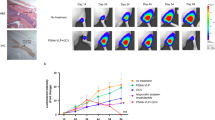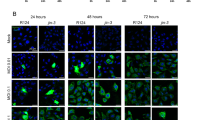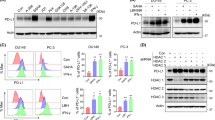Abstract
In this study, we analyzed the preclinical utility and antitumor efficacy of tumor necrosis factor-related apoptosis-inducing ligand (TRAIL) delivered by Ad-IU2, a prostate-specific replication-competent adenovirus (PSRCA), against androgen-independent prostate cancer. Through transcriptional control of adenoviral early genes E1a, E1b and E4, as well as TRAIL by two bidirectional prostate-specific enhancing sequences (PSES), the expression of TRAIL and adenoviral replication was limited to prostate-specific antigen (PSA) and prostate-specific membrane antigen (PSMA)-positive cells. Ad-IU2 induced fivefold greater apoptosis selectively in PSA/PSMA-positive CWR22rv and C4-2 cells than an oncolytic adenoviral control. Furthermore, prolonged infection with Ad-IU2 reversed TRAIL resistance in LNCaP cells. Ad-IU2 showed superior killing efficiency in PSA/PSMA-positive prostate cancer cells at doses five- to eight-fold lower than required by a PSRCA to produce a similar effect; however, this cytotoxic effect was not observed in non-prostatic cells. As an enhancement of its therapeutic efficacy, Ad-IU2 exerted a TRAIL-mediated bystander effect through direct cell-to-cell contact and soluble factors such as apoptotic bodies. In vivo, Ad-IU2 markedly suppressed the growth of subcutaneous androgen-independent CWR22rv xenografts compared with a PSRCA at 6 weeks after treatment (3.1- vs 17.1-fold growth of tumor). This study shows the potential clinical utility of a PSRCA armed with an apoptosis-inducing ligand.
This is a preview of subscription content, access via your institution
Access options
Subscribe to this journal
Receive 12 print issues and online access
$259.00 per year
only $21.58 per issue
Buy this article
- Purchase on Springer Link
- Instant access to full article PDF
Prices may be subject to local taxes which are calculated during checkout





Similar content being viewed by others
Abbreviations
- CMV:
-
cytomegalovirus
- FACS:
-
fluorescence-activated cell sorting
- HER:
-
human embryonic retinoblast
- LDU:
-
lethal dose50 units
- mRFP:
-
monomeric red fluorescent protein
- PSA:
-
prostate-specific antigen
- PSES:
-
prostate-specific enhancing sequence
- PSMA:
-
prostate-specific membrane antigen
- PSRCA:
-
prostate-specific replication-competent adenovirus
- TRAIL:
-
tumor necrosis factor-related apoptosis-inducing ligand
- vp:
-
virus particles
References
Jemal A, Siegel R, Ward E, Hao Y, Xu J, Murray T et al. Cancer statistics, 2008. CA Cancer J Clin 2008; 58: 71–96.
Thompson KE, Hernandez J, Canby-Hagino ED, Troyer D, Thompson IM . Prognostic features in men who died of prostate cancer. J Urol 2005; 174: 553–556; discussion 556.
Jemal A, Siegel R, Ward E, Murray T, Xu J, Thun MJ . Cancer statistics, 2007. CA Cancer J Clin 2007; 57: 43–66.
Coen JJ, Zietman AL, Thakral H, Shipley WU . Radical radiation for localized prostate cancer: local persistence of disease results in a late wave of metastases. J Clin Oncol 2002; 20: 3199–3205.
Han M, Partin AW, Pound CR, Epstein JI, Walsh PC . Long-term biochemical disease-free and cancer-specific survival following anatomic radical retropubic prostatectomy. The 15-year Johns Hopkins experience. Urol Clin North Am 2001; 28: 555–565.
Huggins C, Hodges CV . Studies on prostatic cancer. I. The effect of castration, of estrogen and androgen injection on serum phosphatases in metastatic carcinoma of the prostate. CA Cancer J Clin 1972; 22: 232–240.
Crawford ED, Eisenberger MA, McLeod DG, Spaulding JT, Benson R, Dorr FA et al. A controlled trial of leuprolide with and without flutamide in prostatic carcinoma. N Engl J Med 1989; 321: 419–424.
Eisenberger MA, Blumenstein BA, Crawford ED, Miller G, McLeod DG, Loehrer PJ et al. Bilateral orchiectomy with or without flutamide for metastatic prostate cancer. N Engl J Med 1998; 339: 1036–1042.
Petrylak DP, Tangen CM, Hussain MH, Lara Jr PN, Jones JA, Taplin ME et al. Docetaxel and estramustine compared with mitoxantrone and prednisone for advanced refractory prostate cancer. N Engl J Med 2004; 351: 1513–1520.
Tannock IF, de Wit R, Berry WR, Horti J, Pluzanska A, Chi KN et al. Docetaxel plus prednisone or mitoxantrone plus prednisone for advanced prostate cancer. N Engl J Med 2004; 351: 1502–1512.
Wiley SR, Schooley K, Smolak PJ, Din WS, Huang CP, Nicholl JK et al. Identification and characterization of a new member of the TNF family that induces apoptosis. Immunity 1995; 3: 673–682.
Pitti RM, Marsters SA, Ruppert S, Donahue CJ, Moore A, Ashkenazi A . Induction of apoptosis by Apo-2 ligand, a new member of the tumor necrosis factor cytokine family. J Biol Chem 1996; 271: 12687–12690.
Pan G, O’Rourke K, Chinnaiyan AM, Gentz R, Ebner R, Ni J et al. The receptor for the cytotoxic ligand TRAIL. Science 1997; 276: 111–113.
Pan G, Ni J, Wei YF, Yu G, Gentz R, Dixit VM . An antagonist decoy receptor and a death domain-containing receptor for TRAIL. Science 1997; 277: 815–818.
Kuang AA, Diehl GE, Zhang J, Winoto A . FADD is required for DR4- and DR5-mediated apoptosis: lack of trail-induced apoptosis in FADD-deficient mouse embryonic fibroblasts. J Biol Chem 2000; 275: 25065–25068.
Takeda K, Hayakawa Y, Smyth MJ, Kayagaki N, Yamaguchi N, Kakuta S et al. Involvement of tumor necrosis factor-related apoptosis-inducing ligand in surveillance of tumor metastasis by liver natural killer cells. Nat Med 2001; 7: 94–100.
Degli-Esposti MA, Dougall WC, Smolak PJ, Waugh JY, Smith CA, Goodwin RG . The novel receptor TRAIL-R4 induces NF-kappaB and protects against TRAIL-mediated apoptosis, yet retains an incomplete death domain. Immunity 1997; 7: 813–820.
Emery JG, McDonnell P, Burke MB, Deen KC, Lyn S, Silverman C et al. Osteoprotegerin is a receptor for the cytotoxic ligand TRAIL. J Biol Chem 1998; 273: 14363–14367.
Nesterov A, Lu X, Johnson M, Miller GJ, Ivashchenko Y, Kraft AS . Elevated AKT activity protects the prostate cancer cell line LNCaP from TRAIL-induced apoptosis. J Biol Chem 2001; 276: 10767–10774.
Zhang L, Fang B . Mechanisms of resistance to TRAIL-induced apoptosis in cancer. Cancer Gene Ther 2005; 12: 228–237.
Voelkel-Johnson C, King DL, Norris JS . Resistance of prostate cancer cells to soluble TNF-related apoptosis-inducing ligand (TRAIL/Apo2L) can be overcome by doxorubicin or adenoviral delivery of full-length TRAIL. Cancer Gene Ther 2002; 9: 164–172.
Shankar S, Chen X, Srivastava RK . Effects of sequential treatments with chemotherapeutic drugs followed by TRAIL on prostate cancer in vitro and in vivo. Prostate 2005; 62: 165–186.
Shankar S, Singh TR, Srivastava RK . Ionizing radiation enhances the therapeutic potential of TRAIL in prostate cancer in vitro and in vivo: intracellular mechanisms. Prostate 2004; 61: 35–49.
Walczak H, Miller RE, Ariail K, Gliniak B, Griffith TS, Kubin M et al. Tumoricidal activity of tumor necrosis factor-related apoptosis-inducing ligand in vivo. Nat Med 1999; 5: 157–163.
Ashkenazi A, Pai RC, Fong S, Leung S, Lawrence DA, Marsters SA et al. Safety and antitumor activity of recombinant soluble Apo2 ligand. J Clin Invest 1999; 104: 155–162.
Jo M, Kim TH, Seol DW, Esplen JE, Dorko K, Billiar TR et al. Apoptosis induced in normal human hepatocytes by tumor necrosis factor-related apoptosis-inducing ligand. Nat Med 2000; 6: 564–567.
Lawrence D, Shahrokh Z, Marsters S, Achilles K, Shih D, Mounho B et al. Differential hepatocyte toxicity of recombinant Apo2L/TRAIL versions. Nat Med 2001; 7: 383–385.
Lee SJ, Kim HS, Yu R, Lee K, Gardner TA, Jung C et al. Novel prostate-specific promoter derived from PSA and PSMA enhancers. Mol Ther 2002; 6: 415–421.
He TC, Zhou S, da Costa LT, Yu J, Kinzler KW, Vogelstein B . A simplified system for generating recombinant adenoviruses. Proc Natl Acad Sci USA 1998; 95: 2509–2514.
Fallaux FJ, Kranenburg O, Cramer SJ, Houweling A, Van Ormondt H, Hoeben RC et al. Characterization of 911: a new helper cell line for the titration and propagation of early region 1-deleted adenoviral vectors. Hum Gene Ther 1996; 7: 215–222.
Sramkoski RM, Pretlow II TG, Giaconia JM, Pretlow TP, Schwartz S, Sy MS et al. A new human prostate carcinoma cell line, 22Rv1. In Vitro Cell Dev Biol Anim 1999; 35: 403–409.
Horoszewicz JS, Leong SS, Kawinski E, Karr JP, Rosenthal H, Chu TM et al. LNCaP model of human prostatic carcinoma. Cancer Res 1983; 43: 1809–1818.
Wu HC, Hsieh JT, Gleave ME, Brown NM, Pathak S, Chung LW . Derivation of androgen-independent human LNCaP prostatic cancer cell sublines: role of bone stromal cells. Int J Cancer 1994; 57: 406–412.
Kaighn ME, Narayan KS, Ohnuki Y, Lechner JF, Jones LW . Establishment and characterization of a human prostatic carcinoma cell line (PC-3). Invest Urol 1979; 17: 16–23.
Stone KR, Mickey DD, Wunderli H, Mickey GH, Paulson DF . Isolation of a human prostate carcinoma cell line (DU145). Int J Cancer 1978; 21: 274–281.
Li X, Zhang YP, Kim HS, Bae KH, Stantz KM, Lee SJ et al. Gene therapy for prostate cancer by controlling adenovirus E1a and E4 gene expression with PSES enhancer. Cancer Res 2005; 65: 1941–1951.
Ahn M, Lee SJ, Li X, Jiménez JA, Zhang YP, Bae KH et al. Enhanced combined tumor-specific oncolysis and suicide gene therapy for prostate cancer using M6 promoter. Cancer Gene Ther 2009; 16: 73–82.
Bruder JT, Appiah A, Kirkman 3rd WM, Chen P, Tian J, Reddy D et al. Improved production of adenovirus vectors expressing apoptotic transgenes. Hum Gene Ther 2000; 11: 139–149.
Griffith TS, Broghammer EL . Suppression of tumor growth following intralesional therapy with TRAIL recombinant adenovirus. Mol Ther 2001; 4: 257–266.
Sova P, Ren XW, Ni S, Bernt KM, Mi J, Kiviat N et al. A tumor-targeted and conditionally replicating oncolytic adenovirus vector expressing TRAIL for treatment of liver metastases. Mol Ther 2004; 9: 496–509.
Hu B, Zhu H, Qiu S, Su Y, Ling W, Xiao W et al. Enhanced TRAIL sensitivity by E1A expression in human cancer and normal cell lines: inhibition by adenovirus E1B19 K and E3 proteins. Biochem Biophys Res Commun 2004; 325: 1153–1162.
Bischoff JR, Kirn DH, Williams A, Heise C, Horn S, Muna M et al. An adenovirus mutant that replicates selectively in p53-deficient human tumor cells. Science 1996; 274: 373–376.
Rothmann T, Hengstermann A, Whitaker NJ, Scheffner M, zur Hausen H . Replication of ONYX-015, a potential anticancer adenovirus, is independent of p53 status in tumor cells. J Virol 1998; 72: 9470–9478.
Ganly I, Kirn D, Eckhardt G, Rodriguez GI, Soutar DS, Otto R et al. A phase I study of Onyx-015, an E1B attenuated adenovirus, administered intratumorally to patients with recurrent head and neck cancer. Clin Cancer Res 2000; 6: 798–806.
van Beusechem VW, van den Doel PB, Grill J, Pinedo HM, Gerritsen WR . Conditionally replicative adenovirus expressing p53 exhibits enhanced oncolytic potency. Cancer Res 2002; 62: 6165–6171.
Hallenbeck PL, Chang YN, Hay C, Golightly D, Stewart D, Lin J et al. A novel tumor-specific replication-restricted adenoviral vector for gene therapy of hepatocellular carcinoma. Hum Gene Ther 1999; 10: 1721–1733.
Matsubara S, Wada Y, Gardner TA, Egawa M, Park MS, Hsieh CL et al. A conditional replication-competent adenoviral vector, Ad-OC-E1a, to cotarget prostate cancer and bone stroma in an experimental model of androgen-independent prostate cancer bone metastasis. Cancer Res 2001; 61: 6012–6019.
Rodriguez R, Schuur ER, Lim HY, Henderson GA, Simons JW, Henderson DR . Prostate attenuated replication competent adenovirus (ARCA) CN706: a selective cytotoxic for prostate-specific antigen-positive prostate cancer cells. Cancer Res 1997; 57: 2559–2563.
Yu DC, Chen Y, Seng M, Dilley J, Henderson DR . The addition of adenovirus type 5 region E3 enables calydon virus 787 to eliminate distant prostate tumor xenografts. Cancer Res 1999; 59: 4200–4203.
Hsieh CL, Yang L, Miao L, Yeung F, Kao C, Yang H et al. A novel targeting modality to enhance adenoviral replication by vitamin D(3) in androgen-independent human prostate cancer cells and tumors. Cancer Res 2002; 62: 3084–3092.
Mi J, Li ZY, Ni S, Steinwaerder D, Lieber A . Induced apoptosis supports spread of adenovirus vectors in tumors. Hum Gene Ther 2001; 12: 1343–1352.
Steinwaerder DS, Carlson CA, Otto DL, Li ZY, Ni S, Lieber A . Tumor-specific gene expression in hepatic metastases by a replication-activated adenovirus vector. Nat Med 2001; 7: 240–243.
Qiu S, Ruan H, Pei Z, Hu B, Lan P, Wang J et al. Combination of targeting gene-virotherapy with 5-FU enhances antitumor efficacy in malignant colorectal carcinoma. J Interferon Cytokine Res 2004; 24: 219–230.
Dong F, Wang L, Davis JJ, Hu W, Zhang L, Guo W et al. Eliminating established tumor in nu/nu nude mice by a tumor necrosis factor-alpha-related apoptosis-inducing ligand-armed oncolytic adenovirus. Clin Cancer Res 2006; 12: 5224–5230.
Ren XW, Liang M, Meng X, Ye X, Ma H, Zhao Y et al. A tumor-specific conditionally replicative adenovirus vector expressing TRAIL for gene therapy of hepatocellular carcinoma. Cancer Gene Ther 2006; 13: 159–168.
Acknowledgements
This work was supported by the following funding sources, NIH F31 CA106215-01 (JA Jiménez), NIH R01 CA074042 (C Kao) and DOD W81XWH-04-1-0168 (C Kao).
Author information
Authors and Affiliations
Corresponding author
Rights and permissions
About this article
Cite this article
Jiménez, J., Li, X., Zhang, YP. et al. Antitumor activity of Ad-IU2, a prostate-specific replication-competent adenovirus encoding the apoptosis inducer, TRAIL. Cancer Gene Ther 17, 180–191 (2010). https://doi.org/10.1038/cgt.2009.62
Received:
Revised:
Accepted:
Published:
Issue Date:
DOI: https://doi.org/10.1038/cgt.2009.62
Keywords
This article is cited by
-
Oncolytic virotherapy for urological cancers
Nature Reviews Urology (2016)
-
MiRNA regulation of TRAIL expression exerts selective cytotoxicity to prostate carcinoma cells
Molecular and Cellular Biochemistry (2014)



